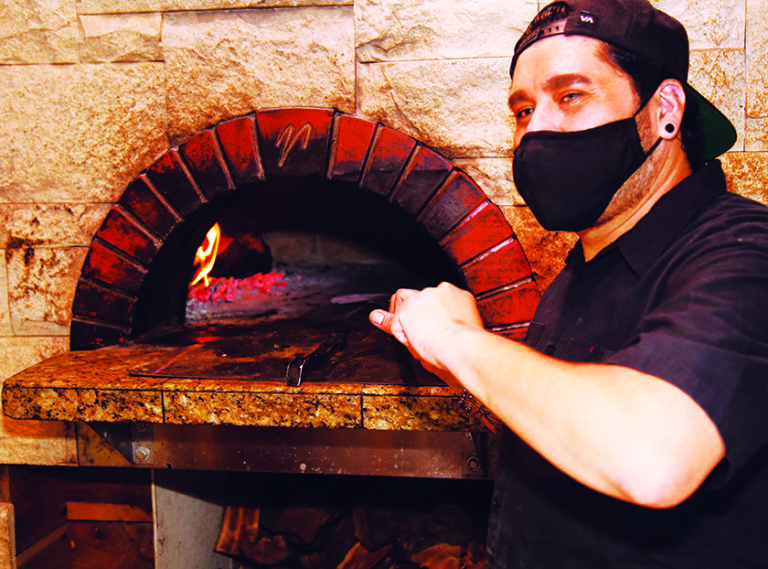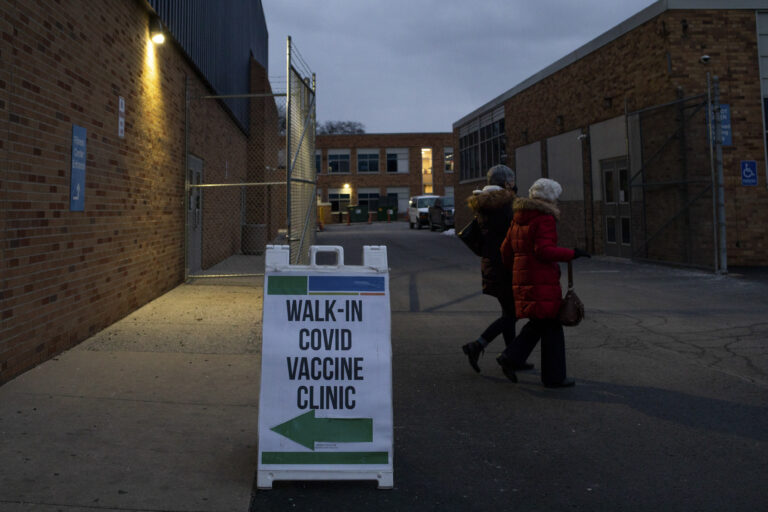By Apoorva Mandavilli, The New York Times
After a frenetic few weeks when the omicron variant of the coronavirus seemed to infect everyone, including the vaccinated and boosted, the United States is finally seeing encouraging signs.
As cases decline in some parts of the country, many have begun to hope that this surge is the last big battle with the virus — that because of its unique characteristics, the omicron variant will usher Americans out of the pandemic.
The variant spiked in South Africa and Britain, then fell off quickly. Twitter is agog over charts showing declining virus levels in sewage in Boston and San Francisco. On Monday, the top European regional official of the World Health Organization suggested that “omicron offers plausible hope for stabilization and normalization.”
“Things are looking good,” Dr. Anthony Fauci, the Biden administration’s top adviser on the pandemic, said Sunday. “We don’t want to get overconfident, but they look like they’re going in the right direction right now.”
What’s driving the optimism? The idea is that so many people are gaining immunity through vaccination or infection with omicron that soon the coronavirus will be unable to find a foothold in our communities, and will disappear from our lives.
But in interviews with more than a dozen public health researchers, immunologists and evolutionary biologists, the course of the virus in the United States appeared more complicated — and a bit less rosy.
By infecting so many people, omicron undoubtedly brings us closer to the end of the pandemic, they said. The current surge in infections is falling back, and there is reason to hope that hospitalizations and deaths will follow.
The path to normalcy may be short and direct, the goal just weeks away, and horrific surges may become a thing of the past. Or it may be long and bumpy, pockmarked with outbreaks over the coming months to years as the virus continues to find footing.
In any case, it is not likely that the coronavirus will ever completely disappear, many scientists said, and herd immunity is now just a dream. The population’s immunity against the virus will be imperfect, for a variety of reasons.
“Maybe there was a short while where we could have reached that goal,” said Shweta Bansal, an infectious disease modeler at Georgetown University. “But at this point, we are well beyond that.”
Instead, the coronavirus seems likely to become endemic — a permanent part of American lives, a milder illness, like the flu, that people must learn to live with and manage.
But the future also depends on a wild card: new variants. Omicron surfaced only at the end of November. Most researchers believe other variants are coming, because too little of the world is vaccinated. Eventually some may be both highly contagious and have a knack for short-circuiting the body’s immune defenses, lengthening the misery for everyone.
“This is a choose-your-own-adventure story, and the ending is not written yet,” said Anne Rimoin, an epidemiologist at the University of California, Los Angeles. “Nobody is going to be able to tell us what will happen.”
As of Wednesday, the United States was reporting more than 650,000 new cases daily, on average, down from more than 800,000 two weeks ago. Deaths continue to rise, at more than 2,300 per day, on average, but hospitalizations seem to be nearing a plateau, at about 155,000 per day, on average.
In the best-case scenario, as those numbers fall, many Americans may soon be able to reclaim much of their prepandemic lives. Perhaps by the spring in the Northeast, and probably later in other regions, many Americans may go to work mask-free, send their children to school and socialize with family and friends without worry.
Only those at high risk from COVID — because of their age, health status or occupation — would need regular boosters tailored to the latest variant.
“If we could keep people out of the hospital and not get terribly ill, I think we could get back to normal basically with the tests and with vaccines,” said Michel Nussenzweig, an immunologist at Rockefeller University in New York.
In the long run, many of us might experience a mild infection every few years, as with coronaviruses that cause the common cold, but would not become seriously ill.
The idea of omicron as the last stand of the coronavirus holds enormous appeal. It’s what everybody wants, every scientist hopes for. But to get there, Americans would need to be both lucky and smart.
An endemic virus does not necessarily indicate a minor threat. Tuberculosis is endemic in India and other countries, and kills more than 1 million people each year. In African countries, measles is endemic. That virus constantly circulates at low levels and periodically triggers large outbreaks.
Earlier in the pandemic, health officials estimated that for the coronavirus, vaccinating about 70% of the population might get us past the herd immunity threshold, meaning the coronavirus becomes a negligible threat.
But the more contagious a variant, the higher the percentage of vaccinated people needed to reach the threshold. When the alpha variant surfaced, scientists revised the level to 90%.
By early last year, they acknowledged that the herd immunity goal was probably out of reach.
Imperfect Immunity
How big a threat the coronavirus remains depends in part on the level of immunity that the country maintains over time. That’s a difficult assessment to make.
There are still millions in the United States and elsewhere who have no protection from the virus and no plans to be immunized. Booster shots are needed to prevent omicron infection, and only about half of eligible Americans have received them.
Moreover, scientists know little about the strength or duration of immunity left by an omicron infection, and they do know that the protection against infections conferred by vaccines wanes after a relatively short period. (The protection against hospitalization and death remains strong over a longer period.)
If the population’s protection against the virus is weak or transient, as is possible, then Americans may continue to experience outbreaks large enough to flood hospitals for years. To contain them, people would have to line up for annual coronavirus shots, perhaps in the fall, as they do for flu shots.
If the virus persists as an endemic threat, the number of people vulnerable to it will also change over time. Young people will age into higher risk groups or develop conditions that put them at risk, and babies will arrive without immunity.
“Whether it’s because of evolution, whether it’s because of waning or whether it’s because of population turnover, we’ve got an influx of susceptibility which allows for future transmission,” said Adam Kucharski, a public health researcher at the London School of Hygiene and Tropical Medicine.
New Variants
The lack of widespread vaccination, in the United States and worldwide, coupled with the uncertainty regarding the strength of immunity left behind by omicron, opens the door to the possibility of new variants. Someday, one of them may dodge immune defenses as well as, or even better than, omicron does.
“I consider omicron an example of what endemic COVID-19 looks like,” said Kristian Andersen, a virus expert at the Scripps Research Institute in San Diego. “But this doesn’t end with omicron, because future variants will emerge.”
Neither vaccines nor infections offer so-called sterilizing immunity, meaning that the protection they offer appears to weaken over time. The protection gained from a delta or omicron infection may not be as effective against new variants, as the virus is changing unexpectedly quickly and in unusual ways.
Viruses typically evolve in a ladderlike pattern, with each new variant developing from the one before it. But the three riskiest variants of the coronavirus — alpha, delta and omicron — evolved independently. The coronavirus wasn’t building on previous work, so to speak; it repeatedly reinvented itself.
As more and more of the world is vaccinated, evolution will favor forms of the coronavirus that can sidestep antibodies and other immune defenses.
“We could get another variant kind of out of the blue that’s responding to a selection pressure that we hadn’t really thought about, or with mutations that we didn’t really put together,” said Emma Hodcroft, a molecular epidemiologist at the University of Bern in Switzerland.
Contrary to popular myth, the coronavirus is not guaranteed to transform into a milder form over time. A virus may evolve to be less virulent if it kills its hosts before it has been passed on to others, or if it runs out of hosts to infect. Neither is true of the coronavirus.
“It doesn’t kill enough of us, to be perfectly blunt, to actually deplete its reservoir of people to infect,” said Jeffrey Shaman, a public health expert at Columbia University. “And it certainly is passed on from an infected person long before the virus kills.”
Even if the next variant is as mild as omicron or even milder, a highly contagious variant may still wreak havoc on the health care system.
“When you’ve got something as transmissible as omicron, you don’t need it to be incredibly severe to really screw things up,” said Bill Hanage, a public health researcher at the Harvard T.H. Chan School of Public Health.
Treading Carefully
The future will also depend on our risk tolerance, both as individuals and as a nation. The most relevant comparison is to the flu virus, which has survived alongside humans for hundreds of years.
Like the coronavirus, the flu is primarily a threat to certain groups — in this case, older adults, children under age 5, and those with weaker immune systems.
The rest of the population takes few precautions. Businesses and schools don’t require negative tests for those who have had the flu, nor do people wear masks to protect themselves against it. Only about half of adult Americans choose to be vaccinated each year.
With the coronavirus, public health officials are just now wrestling with what normal should look like, including which trade-offs are acceptable. But they do acknowledge that trade-offs are coming.
“We don’t have a vision of what level of control we’re aiming for,” said Jennifer Nuzzo, an epidemiologist at Johns Hopkins University’s Bloomberg School of Public Health. “I just don’t think zero cases is the target for any of us.”
This month, a group of former advisers to President Joe Biden called on the administration to plan for a “new normal” that entails living with the coronavirus and the flu long term. Like Nuzzo, they argued that the administration should set targets for the number of hospitalizations and deaths that would trigger emergency measures.
Given how frequently the coronavirus has upended expectations, Americans should hope for the best — but be prepared for living a bit longer with something short of that.
“We all want this to be over,” Shaman said. “But I think we have to be a little more agnostic in our approach to this whole thing.”
“We don’t know,” he added. “We just don’t know.”
This article originally appeared in The New York Times.





















